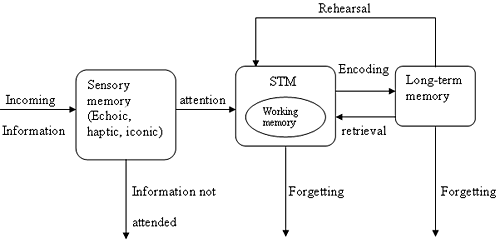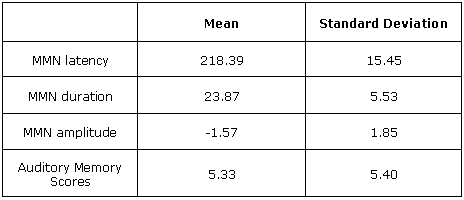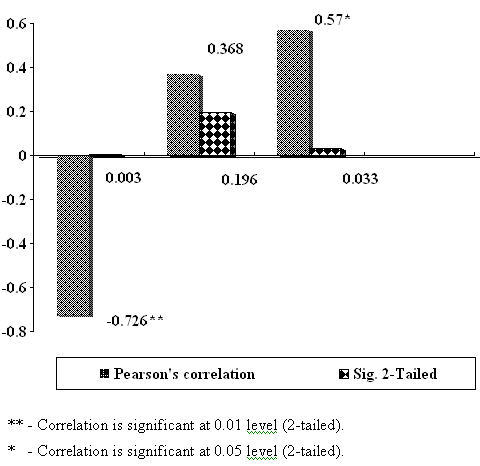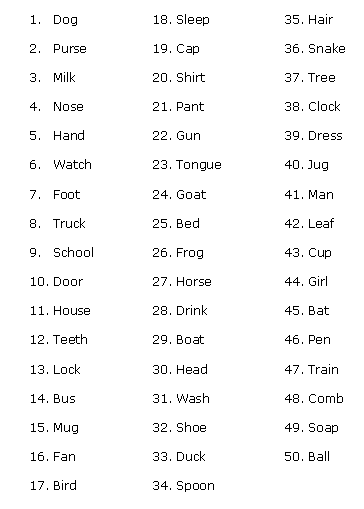Khaladkar Ashok Aditee, Postgraduate student (Audiology), All India Institute of Speech and Hearing, University of Mysore, Mysore, India.
C.S. Vanaja, Ph.D., Lecturer, Department of Audiology, All India Institute of Speech and Hearing, University of Mysore, Mysore, India
NOTE: Portions of the paper were presented at the 36th National Conference of Indian Speech and Hearing Association, 2004 at Mysore, Karnataka, India.
Abstract:
The mismatch negativity (MMN) elicited by infrequent deviants in sequences of auditory stimuli is presumably generated within a neural mechanism that compares the current stimulus to the trace of the previous one. The present study highlights the possible correlation between subjectively evaluated auditory memory performance and objective MMN data. Fifteen adult subjects (18-22 years) with normal hearing were considered for the study. An evoked potential system was used to record an MMN from each subject using an oddball paradigm with a frequent to infrequent (standard to deviant stimuli) ratio of 80%. The parameters of MMN waveform, i.e. peak latency, peak amplitude, duration and morphology were also evaluated.
It was observed that latency of MMN decreased with higher scores in auditory memory task (p
A significant correlation between behavioral sensory (echoic) memory and its physiological measures (MMN) exist. These findings are consistent with previous research. Results indicate that superior performance with the auditory memory task correlates with reduced latency, greater amplitude and improved morphology of MMN.
This research strongly supports the fact that MMN is a neurophysiologic index for the echoic component of sensory memory in audition, which previous research has not significantly highlighted.
Introduction:
Event related potentials (ERPs) have been used for studying various memory mechanisms, their processing strategies and their components. ERPs also provide a means to study neural correlates related to language and speech-sound processing (Korpilahti, Krause, Holopainen, & Lang AH., 2001). Mismatch negativity (MMN) is an ERP which likely measures attention-independent perceptual change detection.
Korpilahti, Krause, Holopainen, and Lang AH (2001) elicited cortical ERPs by using a variety of stimuli; complex tones, naturally spoken words and pseudowords, with each stimulus type containing equal acoustical elements. Tones elicited bifurcated mismatch negativity (MMN), words elicited a strong and late MMN peaking at about 400-450 ms after stimulus onset, pseudowords elcited a MMN wave form which was significantly weaker than the MMN from words.
Uther, Jansen , Huotilainen , Ilmoniemi and Naatanen (2003) examined auditory temporal resolution as indexed by gap detection using the MMN component of the auditory ERP and its magnetic counterpart (MMNm). These stimuli were presented in sequences of repetitive continuous 'standard' sinusoidal tones interspersed with infrequently occurring 'deviant' stimuli. The deviants contained a silent gap midway in the stimulus. Nonetheless, the findings suggested that MMN and MMNm successfully index auditory temporal resolution thresholds, independent of attention.
Alho (1995) reported infrequent ("deviant") sounds occurring in a sequence of repetitive ("standard") sounds elicited an event-related brain potential (ERP) response called the mismatch negativity (MMN) -- even in the absence of attention to these sounds. MMN appears to be caused by a neuronal mismatch between the deviant auditory input and a sensory-memory trace representing the standard stimuli. Thus, localizing cerebral generators of MMN might help identify brain mechanisms related to auditory sensory memory and involuntary attention management.
As noted above, MMN is the component of the auditory event related potential (ERP), elicited independently by an infrequent change in repetitive stimuli (Naatanen, Gaillard, & Mantysalo, 1978). The MMN data shows the existence of a sensory memory trace in which the features of a frequently occurring stimulus are represented. MMN reflects automatic, pre-attentive auditory discrimination, represented as a small negative deflection superimposed on the P2 wave (Lang, et.al., 1995). Several recent studies have also shown these representations govern auditory discrimination abilities (Naatanen and Alho, 1995). However, MMN is not elicited by stimuli with deviant stimulus parameters in the absence of intervening standards. MMN appears has to reflect change detection when a memory trace representing the constant standard stimulus and the neural code of the deviant parameter are discrepant (Naatanen, 1992).
Although the literature suggests MMN reflects echoic sensory memory in humans (Winkler, Reinikainen & Naatanen, 1993), experimental evidence suggests MMN is the physiological correlate of auditory sensory memory. However, the relationship between these mechanisms is still unknown.
Echoic memory refers to -'auditory sensory memory, as the brief auditory impression, that persists after the sound has disappeared' (Neisser, 1967). The maximum numbers of items maintained in the auditory sensory memory is about 5 words lasting 2-10 seconds (Schweickert, 1993). The literature reveals various relationships between echoic memory and sensory memory. The Atkinson-Shiffrin Multistore Model (1968) suggested that echoic memory forms a component of auditory sensory memory in humans (Atkinson and Shiffrin, 1968). Their model postulated that, from the first stage of sensory memory store, where all information is perceived, very little remains and the information is passed from here to short term memory (STM) by attention, as depicted in Figure 1.
Figure 1. The first stage of sensory memory (store, receives all information). Through selective filtering, the information is then passed to STM. From here very little remains, and rest enters the LTM, as depicted.

Atkinson-Shiffrin Multistore Model (1968)
Information processing through various memory sub-systems.
- (From "The psychology of learning and motivation" by R.C. Atkinson and R.M. Shiffrin, 1968. In J.S. Halonen, and J.W. Santrock, 1999, Psychology contexts and applications (3rd ed.). USA: The McGraw Hill Companies, Inc.).
STM allows individuals to hold approximately 5-9 characters (units) for several seconds. According to Miller (1956), individuals can hold only a limited number of items (7+/-2) in STM, also known as "memory span chunks." High individual variation of STM is noted. His experiments strongly suggest STM duration is about 30 seconds.
Research in the field of cognition, highlights the presence of a lingering echo in the human auditory system. Pure sounds can be held for brief intervals to help auditory perception. In order to compare arrival times of two sounds, the first sound needs to be retained until the second one arrives, and echoic memory fills up this gap. Hence, this complex interplay between echoic memory and STM plays a wide role in language processing, perhaps to help retain exact replicas of sound during word and sentence processing (Crowder, 1976; Nairne, 1970).
Echoic memory can be evaluated objectively via MMN, as evidenced by previous researchers (Winkler, Reinikainen, & Naatanen, 1992, 1993;Jaaskelainen, Hautamaki , Naatanen , & Ilmoniemi , 1999). Naatanen (1992) proposed that memory underlying MMN is a sensory memory based on similarities, like duration and a pre-attentive nature. If so, it would be possible for subjective and physiological data to converge while studying the same memory.
In most ERP studies of MMN, subjects usually ignore the stimuli, whereas behavioral studies of sensory memory employ single presentations of comparison stimulus to examine memory.
Lu, Williams and Kaufman (1992), reported similarities in N1 refractoriness and duration of sensory memory trace, determined in a behavioral experiment. They suggested that reduction of the N1 amplitude with repetitive stimulation is due to an habituation process that reflects a persistent excitatory state which encodes the transient memory for the stimulus. Their data indicated an exponential decay in the mnemonic trace, consistent with a trace that lasts for more than 1 second, and less than 10 seconds.
Electrophysiological data suggests that sensory input arguably becomes sensory memory in the auditory cortex, where sensory information corresponds to the actual sound percept and acoustic event. Before arriving at the auditory cortex, the stimulus lacks conscious perception. Of course, there is controversy encompassing the correspondence between MMN and sensory memory. It is unclear whether sensory memory capability could be reflected by MMN. Thus, with respect to many unknowns and discrepancies, the relationship between obligatory evoked potential components and memory is a subject requiring further investigation.
The present study aimed at evaluating the correlation between behaviorally evaluated auditory memory scores and objectively reflected MMN responses.
Method:
Subjects:
Fifteen adult volunteers (6 males; 9 females; mean age 19.5 years) participated in this study. Each had normal pure tone thresholds in each ear and each had normal acoustic reflexes. All subjects were fluent English speakers.
Instrumentation:
A personal computer (PC) with Audio-lab software (Version 1) was used to present the auditory memory task (Yathiraj & Mascarenhas, 2002) and a Biologic navigator (EP 317) evoked potential system was used to record MMN.
Procedure:
Behavioral auditory memory score: During the first test session, the auditory memory task (Yathiraj and Mascarenhas, 2002) was administered and performance scores were obtained. The auditry memory task involved presenting a series of increasing word sequences, from 3 to 8 words, with inter-stimulus intervals (ISIs) of 1 second between words in each sequence. Each sequence was presented only once without repetitions, using a recorded PC version. The protocol lasted for 3-12 seconds.
MMN: During the second test session, subjects were seated in a reclining chair and then four silver chloride electrodes were placed after cleaning the electrode sites with skin preparing paste. Two non-inverting electrodes were placed on Cz and Fz sites with the inverting electrode on the nose-tip and the nasion being the ground terminal. TDH-39P headphones were placed on the pinna to present the stimuli. Subjects were instructed to not attend to the stimuli.
Test protocol: The tone burst stimuli were presented in oddball paradigm with a ratio of 80:20 (frequent: infrequent, in percentage). While the standard stimuli had a duration of 50 msecs, the deviant had duration of 60 msecs. The frequency of the stimuli was set at 1000 Hz. The level of the stimuli was 60 dB SL (ref: HTL for tone bursts) and a repetition rate of 3.1 per second was used (ISI was 283 msecs). Responses were filtered with a band pass filter of 0.1-30 Hz. Responses for 100 deviant stimuli and proportionate number of standard stimuli was averaged.
Analysis:
Presence of MMN was confirmed by visually inspecting the subtracted waveform (infrequent- frequent weighted waveforms). In visual inspection of the subtracted waveforms, the criteria for the presence of MMN were - a trough in the latency range of 50-300 msecs, with a negative potential of more than -0.3 microvolts in either N1P2 or P2N2 complex and a positive peak should follow the negativity. The parameters evaluated from the MMN waveform were:
- Peak latency - time taken for MMN to occur after stimulus onset.
- Peak amplitude - amplitude at the peak of MMN with respect to the zero voltage line.
- Duration of MMN - the difference between the point of onset and termination of the negativity.
- Morphology - visual appearance of waveform.
Table I reveals the mean and standard deviations (S.D.) for peak latency,
peak amplitude, duration of MMN and scores for auditory memory tasks for all fifteen subjects. Inspection of raw data reveals that the latency of MMN was less in subjects with higher scores in auditory memory task. Furthermore, the amplitude of MMN was more in subjects with better scores in auditory memory task. However, duration of MMN did not show any such trend. Pearson's product-moment correlation was calculated between behavioral STM and objective parameters of MMN. Figure 2 depicts Pearson's product-moment correlation values. The behavioral STM demonstrates a significant association with MMN latency (p
Table 1. Mean and standard deviations (S.D.) for latency, duration, peak amplitude of MMN and auditory memory scores.

Figure 2. Behavioral STM data demonstrates a significant association with MMN latency (p

Discussion:
Speech is a continuous, ongoing phenomenon. Not even the smallest segment of speech is available in its entirety at one instant of time. Therefore, the auditory system must wait until sufficient information has been presented before processing even the smallest units of speech. The normal auditory system is capable of retaining peripherally processed information from the cochlea, long enough to identify the smallest units of the pattern.
Norman (1972) postulated the existence of low level neurological internal recording equipped to briefly hold information about the acoustic waveform, internalized as sensory information. Others suggested that after storage in iconic memory, auditory information passes into pre-acoustical storage (Crowder and Morton, 1969), or echoic memory. Ulric Neisser (1967) coined the term echo (or echoic memory) for a phenomenon previously unobserved and concluded there should be two different auditory sensory stores, a short one (phenomena
Characteristics of echoic sensory memory can be well delineated for short term memory, which is the next successive storehouse in the memory model. For example; the former is passive, while the later is active; the former is continuous, the later segmented; former is composed of sounds while the later has speech and while the former decays rapidly, the later can be renewed indefinitely through rehearsal (Neisser, 1967).
Results indicate significant correspondence between behavioral auditory memory and its physiological measure (MMN). Although we could not compare our results from behavioral auditory memory measures to relevant published studies, due to a lack of previous studies, we believe the memory component evaluated via the auditory memory task (Yathiraj and Mascarenhas, 2003) was purely echoic memory, not STM, based on the duration of testing and test material involved. The mean score (5.33) in the auditory memory task lies within the durational boundaries of echoic memory and confirms the information has not reached the conscious level of STM.
However, the association established in the present study between objective and behavioral auditory (echoic) memory, is comparable to past studies, which have shown memory underlying MMN and sensory memory are alike (Naatanen, 1992). It is therefore expected that physiological and behavioral data converge.
One previous study established similarities between N1 peak and duration of a sensory memory trace determined in a behavioral experiment (Lu, Williamson and Kaufman, 1992).
The findings of the present study are in agreement with the Memory-trace Hypothesis (Schroger, 1995) which stated that the brain encodes physical features of the acoustic input as a neural model and compares each input with this norm. If the memory comparison process detects a difference, the MMN is elicited. As better performance with the auditory memory task of an individual is noted, decreased latency, larger amplitude and better morphology of MMN will be present. No significant correlation could be established with duration of MMN. Perhaps the variability in ISI interval between the objective MMN protocol and behavioral auditory memory task, affected the correlation between the duration parameters?
It can be concluded that; MMN reflects the functioning of the echoic memory subcomponent of sensory memory, and, it is possible to objectively predict the auditory sensory memory (echoic memory subcomponent), using objective MMN data. However, MMN does not account for all factors affecting sensory memory. One major limitation of the clinical relevance of the results could be that it is possible to have a good MMN, good echoic memory with poor STM, and vice-versa.
Future studies:
Further investigation to evaluate one-to-one correspondence between objective data (MMN), behavioral correlates and physiological measures, is warranted. There is a need to study the duration parameter (of MMN) more comprehensively, and expansion of these studies into pathological groups (i.e., auditory processing disorders) would likely be highly revealing.
Acknowledgement:
The authors would like to express gratitude to Prof. M. Jayaram, PhD, (Director, All India Institute of Speech and Hearing, Mysore), and Asha Yathiraj, PhD, (HOD, Department of Audiology, All India Institute of Speech and Hearing, Mysore, India), for permitting them to undertake this research venture and the technical assistance offered. Thanks to Risto Naatanen, Kelly Tremblay, Mari Tervaniemi and Nina Kraus for their guidance towards literature review. They authors thank all subjects and staff for their kind assistance. They also thank the reviewers for insightful comments that helped to improve this manuscript.
References:
American National Standards Institute. (1996). American National Standard Specification for Audiometers. (ANSI S3.6-1996). New York: American National Standards Institute.
Atkinson RC, and Shiffrin RM. (1968). Human Memory: A proposed system and its control processes. In Halonen JS, and Santrock JW. (1999). Psychology contexts and applications (3rd ed.). USA: The McGraw Hill Companies, Inc.
Cole R, Colthart M, and Allard F. (1974). Memory of a speaker's voice: reaction time to same or different voiced letters. Quarterly Journal of Experimental Psychology, 26, 1-7.
Crowder RG. (1976). Principles in learning and memory. Hillsdale, NJ: Erlbaum.
Crowder RJ and Morton J. (19690. Preacoustical storage (P.A.S.). Perception and Psychophysics, 5, 365-373.
Eriksen CW and Johnson HJ. (1964). Storage and decay characteristics of unattended stimuli. Journal of Experimental Psychology. 63, 28-36.
Halonen JS and Santrock JW. (1999). Psychology contexts and applications (3rd ed.). USA: The McGraw Hill Companies, Inc.
Jaaskelainen IP, Hautamaki M, Naatanen R, Ilmoniemi RJ. (1999) Temporal span of human echoic memory and mismatch negativity: revisited. Neuroreport. 26, 10(6),
1305-1308.
Korpilahti P, Krause CM, Holopainen I, Lang AH. (2001), Early and late mismatch negativity elicited by words and speech-like stimuli in children. Brain Language. 2001 Mar; 76(3), 332-339.
Lu JL, Williams SJ, and Kaufman L. (1992). Behavioral lifetime of human auditory sensory memory predicted by physiological measures. Science, 258, 1668-1670.
Lang, AH, Eerola O, Korpilahti P, Holopainen I, Salo S, Uusipaikka E, andAaltonen O. (1995). Clinical applications of the mismatch negativity. Ear and Hearing, 16, 117-129.
Miller GA. (1956). The magical number seven plus or minus two: Some limits on our capacity for processing information. Psychological review, 63, 81-97.
Naatanen R. (1992). Attention and brain function. Hillsdale, NJ: Erlbaum.
Naatanen R and Alho K. (1995). Mismatch negativity: A unique measure of sensory processing in audition. International journal of Neuroscience. 80 (1-4), 317-337.
Naatanen R, Gaillard AWK, and Mantysalo S. (1978). Early selective attention effect on evoked potential reinterpreted. Acta psychologica, 42, 313-329.
Nairne JS. (2000). Psychology The adaptive mind. (2nd ed.). Belmont, CA: Wadworth Publishing Co.
Neisser U. (1967). Cognitive psychology. New York: Appleton-Century-Crofts.
Norman, D. A. (1972). The role of memory in understanding of language. In Language by Ear and Eye, eds. J.F. Kavanagh and I.G. Mattingly. Cambridge, Mass.: The MIT Press.
Rout A. (1996). Perception of monosyllabic words in Indian children. Dissertation work submitted in part fulfillment of the Masters Degree in Speech and Hearing, All India Institute of Speech and Hearing, University of Mysore, Mysore.
Schroger E. (1996). The influence of stimulus intensity and interstimulus interval on the detection of pitch and loudness changes. Electrocochleography and clinical neurophysiology, 100, 517-526.
Schweickert R. (1993). A multinomial processing model for degradation and reintegration in immediate recall. Memory & Cognition, 21(2), 168-175.
Uther M, Jansen DH, Huotilainen M, Ilmoniemi RJ, Naatanen R. (2003), Mismatch negativity indexes auditory temporal resolution: evidence from event-related potential (ERP) and event-related field (ERF) recordings. Brain Res Cogn Brain Res. 17(3),
685-691.
Winkler I, Paavilainen P and Naatanen R. (1992). Can echoic memory store two traces simultaneously? A study of event related brain potentials. Psychophysiology, 29(3), 337-349.
Winkler I, Reinikainen K, Naatanen R. (1993). Event-related brain potentials reflect traces of echoic memory in humans. Perception and Psychophysics. 53(4), 443-449.
Yathiraj A and Mascarenhas KE. (2003). Effect of auditory stimulation in central auditory processing in children with CAPD. Project carried out at the Department of Audiology, All India Institute of Speech and Hearing, Mysore.
Appendix A:
(Rout, 1994)


